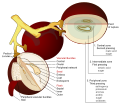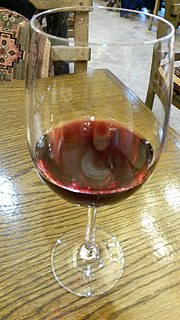The acids in wine are an important component in both winemaking and the finished product of wine. They are present in both grapes and wine, having direct...
18 KB (2,511 words) - 18:58, 17 February 2023
preservative after fermentation. In the mouth, tartaric acid provides some of the tartness in the wine, although citric and malic acids also play a role. Grapes...
26 KB (2,252 words) - 22:27, 21 November 2024
mouthfeel of the wine. The non-flavonoids include the stilbenoids such as resveratrol and phenolic acids such as benzoic, caffeic and cinnamic acids. The natural...
47 KB (5,593 words) - 16:54, 5 September 2024
fenchol and fenchone. Wine portal Oenology Acids in wine Browning in red wine Storage of wine Merriam-Webster. (n.d.). Organoleptic. In Merriam-Webster.com...
29 KB (3,569 words) - 20:00, 29 October 2024
try and harvest while acid levels are acceptable. The major acids in wine are tartaric and malic acid with citric and succinic acids playing a small role...
30 KB (4,279 words) - 13:45, 3 May 2024
Winemaking (redirect from Wine-making)
included, such as acids, amino acids, sugars, and organic compounds. The quality of the grapes determines the quality of the wine more than any other...
52 KB (6,753 words) - 17:23, 28 October 2024
Yeast assimilable nitrogen (redirect from Amino acids in wine)
compounds found in must and wine including peptides, larger proteins, amides, biogenic amines, pyridines, purines and nucleic acids but these cannot...
27 KB (3,491 words) - 18:04, 10 January 2024
make the wine: their sugar content, acidity and the presence of secondary compounds. Vines store sugar in grapes through photosynthesis, and acids break...
12 KB (1,256 words) - 19:28, 18 May 2024
carboxylic acids (the fatty acids), acetic acid does not occur in natural triglycerides. Most of the acetate generated in cells for use in acetyl-CoA...
62 KB (6,559 words) - 16:51, 10 November 2024
wine is determined by the interaction of several factors, including the amount of sugar in the wine, but also the relative levels of alcohol, acids,...
15 KB (1,611 words) - 10:08, 21 October 2024
Acids in wine Citrate–malate shuttle Crassulacean acid metabolism Malate–aspartate shuttle Maleic acid, resulting from malic acid dehydration...
17 KB (1,322 words) - 03:24, 20 November 2024
Fortified wine is a wine to which a distilled spirit, usually brandy, has been added. In the course of some centuries, winemakers have developed many different...
20 KB (2,208 words) - 08:21, 2 November 2024
dry wine and between 200 and 300 grams per litre or even more for Fortified wines) and organic acids, especially malic acid and tartaric acid. Acids occur...
130 KB (15,855 words) - 08:11, 9 November 2024
sulfuric, and sorbic acids. Other acids present in wine, including malic and tartaric acid are considered non-volatile or fixed acids. Together volatile...
11 KB (1,145 words) - 20:47, 9 October 2024
short-chain fatty acid. Like other low-molecular-weight carboxylic acids, it has an unpleasant odor. The compound occurs naturally and can be found in many foods...
12 KB (1,035 words) - 05:43, 10 November 2024
sugar, acid, tannin, nutritive salts for yeast feeding, and water to naturally produce a stable, drinkable wine, so most country wines are adjusted in one...
20 KB (2,417 words) - 09:34, 30 August 2024
Hydroxycinnamic acids (hydroxycinnamates) are a class of aromatic acids or phenylpropanoids having a C6–C3 skeleton. These compounds are hydroxy derivatives...
2 KB (191 words) - 10:31, 21 May 2021
quality of wine. Wine writers differentiate wine tasters from casual enthusiasts; tasters attempt to give an objective description of the wine's taste (often...
16 KB (1,901 words) - 23:35, 22 August 2024
oldest evidence of ancient wine production has been found in Georgia from c. 6000 BC (the earliest known traces of grape wine), Iran from c. 5000 BC, Greece...
64 KB (6,884 words) - 20:30, 29 October 2024
involving a wine's sugars, acids and phenolic compounds (such as tannins) can alter the aroma, color, mouthfeel and taste of the wine in a way that may...
28 KB (3,657 words) - 10:23, 15 October 2024
Vinegar (redirect from Red wine vinegar)
wine') is an aqueous solution of acetic acid and trace compounds that may include flavorings. Vinegar typically contains from 5% to 18% acetic acid by...
48 KB (5,369 words) - 06:25, 16 November 2024
acids, enzymes or other nutrients. Wine is produced by fermenting crushed grapes using various types of yeast. Yeast consumes the sugars found in the...
21 KB (1,827 words) - 21:44, 15 October 2024
concentration in low pH (high acid) wines, serves as a catalyst in the formation of esters from carboxylic acids and alcohols present in the wine. However...
13 KB (1,730 words) - 03:18, 30 October 2024
gets its name from the use of NaOH in acid–base titration to estimate the quantity of titratable acid. Acids in wine Nosek, Thomas M. "Section 7/7ch12/7ch12p27"...
1 KB (132 words) - 20:45, 21 December 2022
Dental erosion (redirect from Erosive acid reflux)
Acid erosion is a type of tooth wear. It is defined as the irreversible loss of tooth structure due to chemical dissolution by acids not of bacterial origin...
20 KB (2,189 words) - 19:37, 23 July 2024
Closely related acids: isocitric acid, aconitic acid, and propane-1,2,3-tricarboxylic acid (tricarballylic acid, carballylic acid) Acids in wine This still...
36 KB (3,660 words) - 20:06, 16 November 2024
prepared and isolated gluconic acid using the glucose fermentation. Gluconic acid occurs naturally in fruit, honey, and wine. As a food additive (E574),...
13 KB (1,191 words) - 14:06, 11 September 2024
Erythorbic acid: a diastereomer of ascorbic acid. Mineral ascorbates: salts of ascorbic acid Acids in wine Safety (MSDS) data for ascorbic acid. University...
24 KB (2,359 words) - 19:48, 27 October 2024
lactic acid Category:Lactate esters Acids in wine Alanine cycle Biodegradable plastic Dental caries MCT1, a lactate transporter Thiolactic acid Methacrylic...
39 KB (4,188 words) - 22:37, 14 November 2024
In food processing, fermentation is the conversion of carbohydrates to alcohol or organic acids using microorganisms—yeasts or bacteria—without an oxidizing...
20 KB (1,772 words) - 10:17, 25 October 2024


























